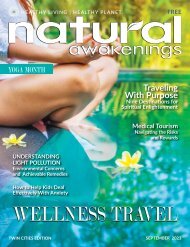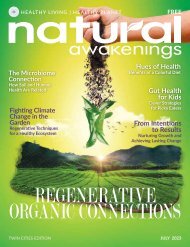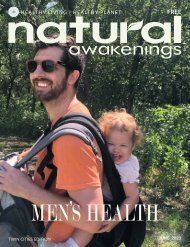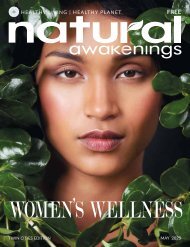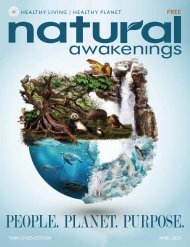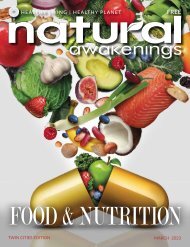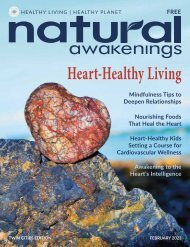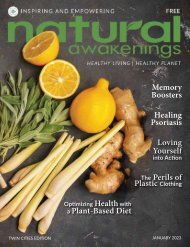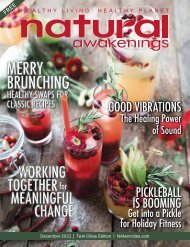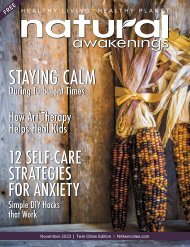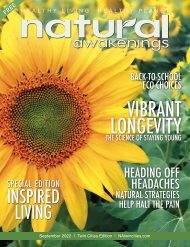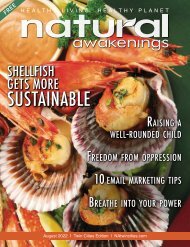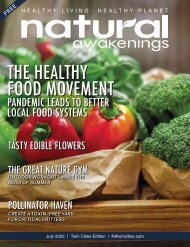Natural Awakenings Twin Cities September 2021
Read the September 2021 edition of Natural Awakenings Twin Cities magazine. This is our annual Inspired Living Issue which is focused on Creativity in Health and Healing and Integrative Pain Management. Topics also include the power of the written word, finding pain relief in essential oils, natural approaches to combating opioid abuse, creative kids, and so much more! Be sure to check out our local content including News Briefs announcements, Community Resource Guide with providers throughout the metro who can meet your individual wellness needs, and all the happenings in the Calendar of Events. There is additional online-only content that can be found at NATwinCities.com. While you are there, be sure to sign up for our Newsletter and Digital Magazine and continue your reading with our archived articles from local experts.
Read the September 2021 edition of Natural Awakenings Twin Cities magazine. This is our annual Inspired Living Issue which is focused on Creativity in Health and Healing and Integrative Pain Management. Topics also include the power of the written word, finding pain relief in essential oils, natural approaches to combating opioid abuse, creative kids, and so much more!
Be sure to check out our local content including News Briefs announcements, Community Resource Guide with providers throughout the metro who can meet your individual wellness needs, and all the happenings in the Calendar of Events. There is additional online-only content that can be found at NATwinCities.com.
While you are there, be sure to sign up for our Newsletter and Digital Magazine and continue your reading with our archived articles from local experts.
Create successful ePaper yourself
Turn your PDF publications into a flip-book with our unique Google optimized e-Paper software.
“It helps me make sense of the world,” she says. “Art gives my<br />
voice and thoughts an outlet, something concrete and representational<br />
that reaches into the depth of what I’m experiencing.”<br />
Redemption Songs in Skid Row<br />
About 10 years ago, violinist and recording artist Vijay Gupta<br />
took a wrong turn and ended up in Skid Row, a disadvantaged<br />
downtown Los Angeles neighborhood. “It felt like a gut punch,”<br />
he recalls. “I saw the gross inequality between Walt Disney<br />
Concert Hall where I performed for the LA Philharmonic and a<br />
community of 5,000 people less than two miles away sleeping in<br />
tents in extreme poverty.”<br />
To uplift and inspire people recovering from homelessness,<br />
addiction and incarceration, Gupta founded Street Symphony in<br />
2011 as a series of concert performances by world-class musicians.<br />
“One of our first venues was the Department of Mental Health,”<br />
he recalls. “After the second movement, the young violist I was<br />
performing with turned to the audience with tears in his eyes and<br />
said, ‘I’ve loved playing for you because I can feel your hearts.’<br />
He shared that his mother had grappled with schizophrenia, his<br />
father was a prison guard and whenever he played for his family,<br />
he felt more connected to them. That’s when I began to see him as<br />
a human being who was in deep need of this work himself.”<br />
Gupta has learned firsthand that healing is a two-way street.<br />
“When I come to Skid Row, I’m the one who feels lifted,” he says.<br />
As a result, Street Symphony has morphed into a collection of<br />
workshops and conversations that also employs jazz, reggae,<br />
hip-hop and West African musicians and vocalists from the Skid<br />
Row community. “We might play 30 minutes of music and then<br />
ask the audience what images, thoughts or memories came up for<br />
them,” he explains.<br />
In this community, art is neither entertainment nor a commodity,<br />
Gupta says. “It’s a lifeline; a way for people that have<br />
been devastated by poverty, addiction or trauma to add to their<br />
lives in a constructive way. We all have devastated places within<br />
ourselves that need healing and attention. Visiting Skid Row is<br />
a pilgrimage to the broken place within myself, and in that way,<br />
it’s a spiritual place; my temple where I go to worship.”<br />
Creative Care for People with Dementia<br />
Drawing from her theater background, Anne Basting, author of<br />
Creative Care, has developed an innovative approach to dementia<br />
and elder care. “Our current caregiving model envisions one<br />
person that’s empty and has lots of needs and the other person<br />
that’s full and pours themself into the other person, which leads<br />
to burnout,” she says. “Dementia and aging are experiences of<br />
increasing separation. People isolate themselves and learn not to<br />
trust their own expressive capacities, because their relatives and<br />
friends no longer know how to relate with them and often ignore<br />
their words.”<br />
Basting’s Creative Care changes this depleting dynamic. “In<br />
improvisational theater, you observe everything that’s happening<br />
on stage and try to figure out how you can add to the<br />
performance positively,” she explains. “Applying that idea to a<br />
care situation, you observe the person’s facial expressions, what<br />
they’re saying, how they’re behaving and then invite them into<br />
expression out of that moment with what we call a ‘beautiful<br />
question’, one that has no right or wrong answers and draws on<br />
the person’s strengths.”<br />
A beautiful question might be, “If your feet could talk, what<br />
would they say?” This offers people with pain a poetic way to<br />
express it. “I invited a gentleman with dementia who had no<br />
language—no words left—to show me how water moves. His<br />
response was the most beautiful dance I’d ever experienced,<br />
performed in the kitchen of his duplex,” Basting recalls, adding<br />
that it’s important to acknowledge the person’s expression so<br />
they know they’ve been heard.<br />
The final step in Creative Care is to accumulate these experiences<br />
over time and shape something larger and universally<br />
meaningful that can be shared with others—an artistic product.<br />
Basting founded the nonprofit TimeSlips to train artists and caregivers<br />
worldwide to do this visionary work. Their efforts have<br />
resulted in art exhibits, dance and theater productions, books and<br />
animations. “My dream is that meaning and beauty will be made<br />
every day in nursing homes, creating care settings so interesting<br />
that people want to visit them—a new kind of cultural center,<br />
integrating health and art,” she says.<br />
Transforming a City with Public Art<br />
More than 4,000 works of public art grace the city of Philadelphia,<br />
three-quarters of which are breathtaking murals that combine<br />
world-class paintings and images with provocative words<br />
and healing messages. Art permeates virtually every neighborhood<br />
on walls, billboards, sidewalks, rooftops, swimming pools<br />
and basketball courts, enriching people from all walks of life,<br />
even those that don’t have access to galleries and museums.<br />
“Public art lifts our spirits, provides us with beauty and<br />
inspires us,” says Jane Golden, founder and executive director<br />
of Mural Arts Philadelphia (MAP). “It can be evocative, challenging<br />
and educational, as well, serving as a barometer of our<br />
time—a system of checks and balances and a mirror that we hold<br />
up to people and say that your life counts and you matter.” In<br />
addition to sponsoring 75 to 100 new works every year, MAP’s<br />
$10 million budget funds programs related to criminal justice,<br />
art education, housing insecurity, behavioral health, community<br />
development and environmental justice.<br />
According to Golden, the healing power of art is not just in<br />
the mural, but also in its collaborative creation. In addition to<br />
artists and educators, hundreds of people work on these projects,<br />
including individuals grappling with addiction or homelessness,<br />
veterans with PTSD and immigrants and refugees facing isolation<br />
and stigma. “The act of creating is a meditative and healing experience,<br />
and because you’re part of a larger effort, it connects you<br />
to your community,” Golden says. “People start to feel a sense of<br />
purpose and value. They start to believe in themselves again.”<br />
Sandra Yeyati, J.D., is a professional writer and editor. Reach<br />
her at SandraYeyati@gmail.com.<br />
18 <strong>Twin</strong> <strong>Cities</strong> Edition NAtwincities.com



